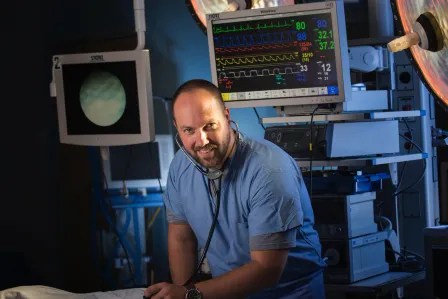
Saba’s guide to studying anatomy at medical school
If you want advice on the best way to study anatomy as a medical student, take a look at this anatomy study guide.
How to study anatomy at medical school
Anatomy is an important part of all medical school programs. Everyone working in the medical and healthcare fields, including doctors, needs to have a good working knowledge of anatomy. Anatomy is a huge and complex subject area – from the largest bones to the smallest glands, a medical student needs to know everything there is to know about anatomy. If you want advice on the best way to study anatomy, take a look at this anatomy study guide.
What is anatomy?
Anatomy is the field of medicine that studies the structures of the human body. This includes bones, glands, muscles, organs, and more.
While modern imaging technology has made it possible to study the anatomy of living creatures, Saba values the importance of learning about anatomy with cadavers.
Knowing how all the parts of the body work together helps with the diagnosis and treatment of illnesses, which is why it’s so important to know how to study anatomy in med school.
What are the branches of anatomy?
When looking at how to learn anatomy, you’ll first have to know the different things you’ll need to learn. Since anatomy is looking at the structure of a body, there are different branches of anatomy, based on the different ways we can look at the body.
Gross anatomy
Gross anatomy is also called macroscopic anatomy. This refers to anatomical features that are large enough to see with the naked eye, such as skin or bones. Gross anatomy is further split into:
- Surface anatomy – Everything on the surface of the body
- Regional anatomy – The anatomy of a specific area of the body, for example, the head
- Systemic anatomy – A specific organ system, for example, the digestive system
Microscopic anatomy
Microscopic anatomy focuses on anatomy at the tissue level or cellular level, and how cells form larger structures. This type of anatomy is typically studied with tools such as microscopes. Microscopic anatomy is further split into:
- Histology – Tissue, such as connective tissue or muscles
- Cytology – Cells, including samples from sputum, urine, or blood
Difference between anatomy and physiology
While medical schools often teach them together, physiology is separate from the study of anatomy. Anatomy is the study of the structure of the parts of an organism, such as the human body. Meanwhile, physiology focuses on the way those parts work and function together.
For example, the heart’s anatomy means the heart’s structure, such as its valves, veins, chambers, and arteries. The physiology of the heart means how the heart pumps the blood.
Anatomy and physiology are both fundamental fields of biology and relate to the body parts of living beings. While the two fields are different, they both interact together and rely on each other. So, physiology is another thing that medical students have to learn while studying anatomy. It’s complicated considering you can’t learn one without learning the other, and that is why an eagerness to learn is such a key factor that we look for in medical students.
Why do you need to study anatomy as a medical student?
Studying anatomy is important as it lays the foundation for everything else in medicine. You’ll need to know anatomy for performing physical examinations on patients, carrying out procedures, examining test results, and discussing cases with patients or other physicians.
Knowing anatomy, along with physiology, lets you determine what help a patient needs – it really is a building block for all medical care. Once you know how to study anatomy in med school, you’ll be able to gain useful knowledge that will take you from your course, to your clinical rotations, and into working as a doctor.
How to study anatomy
Anatomy is a subject where there’s a lot to learn, so it’s vital to have a good study plan. Here is our study guide for human anatomy and physiology, which should give you all you need to know how to study anatomy in medical school.
Create an anatomy glossary
There are so many terminologies to remember in anatomy – there are hundreds of bones, as well as plenty of organs and other parts of the body, and you need to know the names for all of them. Try making a glossary to help you remember key terms. You can even color code the glossary to help.
Routine and resources
Establish a non-negotiable study routine for yourself. Study key concepts frequently and often, making sure to set time aside for more challenging material. Practice makes perfect – or, at least, practice makes permanent. You can also use flashcards, mnemonics, and diagrams to help and make studying easier.
Study as soon as you can
If you’ve got a test coming up, don’t leave it till the last minute to study. Make sure you revise well in advance and get through any additional reading long before your grades depend on it.
Look for study groups, or make a group
It’s always worth asking people in your classes to study together. This can be a great way to go over notes from lectures and cement the knowledge you’ve learned. You can also quiz one another, as well as help each other with things you’re struggling to understand.
Test your knowledge
Testing yourself is a great way to see where your weak spots are. You can use old exam papers or write your own quizzes – especially if you have a study group so you can all think up very hard questions to test each other – and find out where you need to study more.
Make the most of dissection and anatomy tutorials
Dissections are still a great way to learn anatomy. If your school offers dissection sessions, you should be prepared. Try to learn a bit about the subject body part before the session and think up any questions you might want to ask. If your school does not offer dissections, you could try to find dissection explanations online.
Break it down into sections
The human body is a massively complex machine, and it would be very hard to learn all about the anatomy of the entire body at once. Instead, break the subject down into sections, and link them together later. This can help you learn the smaller details, such as the different chambers and parts of the heart, without getting overwhelmed. If you color code your study notes, you can also color code these so you can check through your glossary more easily.
Link anatomy and physiology
One of the easiest ways to remember how something is built is to consider what it has to do. Remember to link your physiology knowledge to your anatomy knowledge to remember what every part of the body does.
Take detailed notes
Taking detailed notes or having a recording of your lectures can help make sure that you get all the details right when you are writing up your revision notes later. Include all the detail you think you’ll need.
Learn anatomy at Saba University
Anatomy might be hard to learn, but this knowledge will stick with you for the rest of your career and is invaluable to learn early.
If you like the idea of learning complex subjects like anatomy, then medical school could be right for you. Interested in pursuing a career in medicine? Apply now to Saba University School of Medicine. You can also contact us for advice or answers to any questions you might have. Alternatively, check out our events and webinars for information on our courses and the application process.

For prospective students
Saba is committed to supporting prospective students with any questions or queries throughout the application process. Please see the following links for detailed information about each topic:
If the information you are seeking is not provided here, please get in contact by contacting via WhatsApp here.
Get in touch for more information